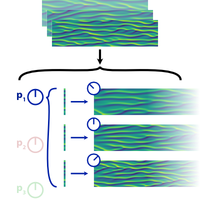Abstract
Experimental data are often affected by uncontrolled variables that make analysis and interpretation difficult. For spatiotemporal systems, this problem is further exacerbated by their intricate dynamics. Modern machine learning methods are particularly well suited for analyzing and modeling complex datasets, but to be effective in science, the result needs to be interpretable. We demonstrate an unsupervised learning technique for extracting interpretable physical parameters from noisy spatiotemporal data and for building a transferable model of the system. In particular, we implement a physics-informed architecture based on variational autoencoders that is designed for analyzing systems governed by partial differential equations. The architecture is trained end to end and extracts latent parameters that parametrize the dynamics of a learned predictive model for the system. To test our method, we train our model on simulated data from a variety of partial differential equations with varying dynamical parameters that act as uncontrolled variables. Numerical experiments show that our method can accurately identify relevant parameters and extract them from raw and even noisy spatiotemporal data (tested with roughly 10% added noise). These extracted parameters correlate well (linearly with ) with the ground truth physical parameters used to generate the datasets. We then apply this method to nonlinear fiber propagation data, generated by an ab initio simulation, to demonstrate its capabilities on a more realistic dataset. Our method for discovering interpretable latent parameters in spatiotemporal systems will allow us to better analyze and understand real-world phenomena and datasets, which often have unknown and uncontrolled variables that alter the system dynamics and cause varying behaviors that are difficult to disentangle.
2 More- Received 27 August 2019
- Revised 6 May 2020
- Accepted 21 July 2020
DOI:https://doi.org/10.1103/PhysRevX.10.031056
Published by the American Physical Society under the terms of the Creative Commons Attribution 4.0 International license. Further distribution of this work must maintain attribution to the author(s) and the published article’s title, journal citation, and DOI.
Published by the American Physical Society
Physics Subject Headings (PhySH)
Popular Summary
Scientists have long strived not only to model and predict complex systems, such as fluid flow and electromagnetism, but also to break them down and understand their fundamental aspects. However, in the face of complex and chaotic dynamics, like those governing weather phenomena, it becomes very difficult to distinguish between the inherent dynamics and changes caused by varying external influences. In such an uncontrolled setting, scientists are in need of new tools to help them disentangle these effects and understand the underlying physics. Applying recent advances in machine learning combined with a physics-informed model design, we demonstrate precisely such a tool, providing the ability to automatically extract interpretable parameters that govern the changes in dynamics seen in the data.
Though machine learning is traditionally thought of as a black-box method used for image recognition or time-series prediction, modern unsupervised learning techniques can be adapted to provide interpretable results for physical systems by incorporating key physical constraints. Specializing in datasets from spatiotemporal systems, our method is designed to extract interpretable physical parameters and to provide a tunable predictive model of the dynamics, all without prior knowledge of the underlying system. For example, given raw data generated by a chaotic model for a flame front, we show that our method automatically identifies and extracts a varying viscosity damping parameter that controls the propagation dynamics.
Our method is an example of how data-driven techniques can provide scientists with new tools for predicting and understanding the physics behind complex dynamical systems.



